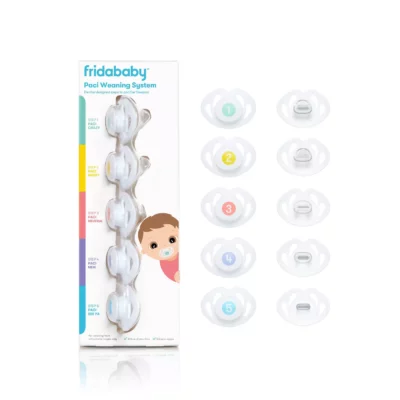The pacifier has provided hours of soothing, sucking comfort. But there comes a point when it must go. When should your little one quit the pacifier? And what’s the best way to do it?
Read on for the 411 on ditching the pacifier!
1. Time It Right

Pacifiers can help prevent Sudden Infant Death Syndrome (SIDS), so it’s important to allow your baby to use one if she likes until she’s six months old, when the risk of SIDS greatly diminishes, says WebMD. And don’t try to wean your little one off her pacifier during major life events like starting a new daycare or a household move, when your baby could use the extra soothing.
2. It’s a Must-Do By Age Two

Before age two, your baby won’t suffer any long-term damage to her teeth, according to WebMD.  Any  problems that do develop before that time will likely self-correct within six months of kicking the pacifier habit. After age two, problems including slanting teeth can begin to occur. And pacifier use beyond age four, when adult teeth begin to form, can mean long-term dental issues.
3. Some Experts Say Quit It By 12 Months

Frequent pacifier use past 12 months old could interfere with a child’s language development skills, say some experts. The reason is two-fold: A child might be less likely to practice making sounds and words when she has a binky in her mouth, plus the act of sucking on the soother might cause the tongue and lip muscles to develop abnormally. It’s possible prolonged use of a pacifier could contribute to the development of a lisp.
4. Going Cold Turkey Might Be Best

It might make for a rough couple of days, but then the attachment to the pacifier is over, says WebMD. Thankfully, there are kind and gentle ways to ditch the binkies once and for all. Your little one treasures her pacifier, so be sure to treat it like a good friend to whom you must bid a fond adieu. Read on for some ideas of how to sweetly help your child give up her pacifier.
5. Get Everyone Onboard

Make sure all caregivers are aware of your plans for the pacifier. You want the message and experience regarding pacifier use to be consistent at home, at daycare, and at grandma’s, or you’ll risk confusing your child. So if you want the pacifier used only at nap-time or bedtime, for example, be sure to communicate to all adults involved.
6. Pacifier Weaning System

There is a product for everything right? If everything else fails this Weaning System from fridaybaby might be worth a go. Invented by a pediatric dentist, it is aimed at 6-18 month kiddos and is based on a 5 step system where the BFA and Latex free nipples get shorter and shorter, gradually making the sucking satisfaction less satisfying and making the transition away from a pacifier easier.
7. Offer Alternative Comforts

When you first take away the pacifier from your baby, you’ll probably need to soothe her in other ways. Rocking, a gentle swinging motion, soft singing, and gentle massage are some ways you can help ease your baby’s discomfort and help her settle down without the aid of a pacifier, says the Mayo Clinic. For older babies, blankets with a soft satiny edge or a snuggly stuffed animal could provide the comfort your little one desires.
8. Wean Her Off

If simply taking it away doesn’t interest you, try slowly weaning your little one off of her pacifier. Start by giving it only at nap-time and bedtime. After a couple of weeks, stop offering it at nap-time. If your little one fusses, try giving her a cuddly toy instead, or comfort her through rocking and other soothing gestures. Once your child is adjusted to napping without the pacifier, it’s time to work on bedtime. At first you might just remove it from the crib after your baby is asleep and has spit it out, then begin putting her down without it.
9. Give Them Away

Some moms have success using reason with their toddlers. You could explain to your child that she is now a big girl and that there is a baby out there who needs her pacifiers to stop crying. Engage your little one in decorating a box for the baby, then gather up all of the pacifiers and place them in it. If you have a friend with a baby, make a big deal about handing over this box for the baby, or take it to a pediatric dentist who will distribute the binkies to babies (wink, wink). Be sure to offer a lot of praise and a small gift to your toddler for being such a kind and generous “big kid.”
10. Make Them Unappealing

If your little one is very attached to his pacifier, it might take making the soother extremely unappealing to help him break the habit. One way to do this, dip the pacifiers in lemon juice or vinegar; the terrible taste could turn him off the silicon “dummies” for good. Another way many moms try is by cutting off the tip, which disables the sucking power of the pacifier. Please be aware that altering a pacifier could make it a choking hazard if the pieces come apart.
11. Introduce the Binky Fairy

Here’s a fun way to say goodbye to those pesky pacifiers: stage a visit from the Binky Fairy. Tell your toddler the Binky Fairy will come as soon as he is ready to be done with his pacifier. Help him collect all of the pacifiers and place them in a box on the doorstep, or in a fancy basket that you can hang from a tree outside. Make this ritual as big of a production as you feel is necessary to help your child let go of his prized soothers. The Binky Fairy will then pay a visit to collect the box and leave a toy in its place.
